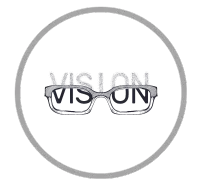Specialty Contacts
Hybrid vs. Scleral: Choosing Well
FSDAVCFEBFEVSDDVFSD
FSDAVCFEBFEVSDDVFSD
FSDAVCFEBFEVSDDVFSD
When Each Design Makes Sense
Patients with keratoconus, corneal ectasia, or pellucid marginal degeneration often benefit from specialty lenses designed for their condition. Hybrid vs. scleral lenses is a common comparison. Hybrids have a rigid center with a soft skirt, offering both clarity and comfort. Scleral lenses vault over the cornea and rest on the sclera, creating a fluid reservoir that relieves dryness.
Choosing between these irregular cornea contacts depends on cone location, ocular surface health, lifestyle, and handling preferences. At Kleinwood Vision, our doctors assess corneal topography, tear film stability, and visual demands to recommend the best lens. With proper fit, most patients achieve stable, long-term comfort.
Patients with keratoconus, corneal ectasia, or pellucid marginal degeneration often benefit from specialty lenses designed for their condition. Hybrid vs. scleral lenses is a common comparison. Hybrids have a rigid center with a soft skirt, offering both clarity and comfort. Scleral lenses vault over the cornea and rest on the sclera, creating a fluid reservoir that relieves dryness.

Choosing between these irregular cornea contacts depends on cone location, ocular surface health, lifestyle, and handling preferences. At Kleinwood Vision, our doctors assess corneal topography, tear film stability, and visual demands to recommend the best lens. With proper fit, most patients achieve stable, long-term comfort.

Comfort, Vision, and Daily Handling
For visual clarity, keratoconus contacts must align properly with the eye’s surface. Scleral lenses often provide more stable optics, especially for moderate to severe corneal irregularities, due to their ability to vault over the cornea and create a smooth optical surface. Hybrid lenses can also perform well if the lens centers correctly and dryness is managed, making them a viable option for some patients.
In terms of scleral lens comfort, these lenses rest on the white part of the eye (the sclera), which helps reduce corneal sensitivity and discomfort. Hybrids may feel lighter on the eye and can be quicker to insert, especially for those familiar with soft lenses. While both lens types require some practice, daily consistency helps make the routine second nature.
Handling and care differ between the two. Sclerals require a full saline fill and are inserted using a plunger, while hybrids follow a more familiar application process and need a hybrid lens care regimen with GP-approved solutions. Regardless of lens type, using tools like a stable mirror, lens stands, and tissue-ready workspaces can make daily routines smoother and more efficient. Proper technique and setup contribute greatly to long-term success and comfort.
Scleral Lens Troubleshooting and Care Systems

With hybrids, issues like edge awareness or dryness may occur. These are typically resolved by adjusting the skirt curve or improving the surface cleaning routine. Proper hybrid lens care includes using approved GP cleaners, rinsing thoroughly, and storing lenses in clean, dry cases. Maintaining hygiene and consistency helps reduce irritation and supports clear, comfortable wear throughout the day.
Scleral lenses may present challenges such as scleral lens bubbles, midday fogging, or redness. These concerns can often be managed by improving the saline fill technique, enhancing surface cleaning, or adjusting the lens’s edge lift.

Using high-quality, preservative-free saline and cleaning tools like plungers and stands can improve results. If problems persist, bring photos of your care setup and lens wear patterns to your appointment. Small, precise adjustments often restore full-day comfort, clarity, and a better overall lens-wearing experience.
Any of the following signs should prompt a same-week review: redness after removal, shrinking wear time, fluctuating vision, or repeated fogging. Whether you’re using keratoconus contacts or lenses for corneal ectasia, these symptoms may indicate that your current fit or care routine needs adjustment. Ignoring these early warning signs can lead to worsening discomfort or reduced effectiveness of your specialty lenses.
Bring your lenses, storage cases, saline, cleaning products, and a short wear log to your next visit. This allows your eye care provider to assess your routine and lens condition accurately. Minor modifications—such as adjusting the landing zone, switching to a different cleaning product, or refining your insertion technique—can significantly improve comfort, clarity, and corneal health. Timely reviews help preserve long-term success with keratoconus contacts or scleral lenses for corneal ectasia. Don’t wait for symptoms to escalate—small tweaks often lead to big improvements in your overall lens-wearing experience.
Cost, Follow-Ups, and Long-Term Results
Lens costs include fitting exams, lens fabrication, care systems, and eventual replacements. Follow-up visits in the first 1–2 months are important to confirm stability and ensure your lenses are performing as intended. These appointments allow for early adjustments that can improve comfort, vision, and long-term lens success.
Over time, the ideal lens may change based on factors like screen time, dryness, allergens, or work environment. Whether you begin with a hybrid or a scleral lens, long-term success depends on how well the lens supports both your vision and overall eye health. If your needs evolve, refitting from hybrid to scleral—or vice versa—remains an option at Kleinwood Vision. Regular check-ins and open communication help ensure that your lens solution continues to meet your changing lifestyle and ocular needs.
A Simple Scleral Lens Decision Pathway
Start by identifying your top priority: is your main goal dryness relief, maximum stability, or quick handling? Knowing what matters most helps guide the right lens choice from the start.
Next, consider your personal constraints—such as your daily schedule, finger dexterity, budget, and whether your job involves airborne particles or long hours in front of a screen. These lifestyle factors play a big role in lens success and comfort.
Start by identifying your top priority: is your main goal dryness relief, maximum stability, or quick handling? Knowing what matters most helps guide the right lens choice from the start.
Next, consider your personal constraints—such as your daily schedule, finger dexterity, budget, and whether your job involves airborne particles or long hours in front of a screen. These lifestyle factors play a big role in lens success and comfort.

After testing a trial lens at home, choose the one you can wear consistently, clean safely, and trust for daily use. Houston specialty contacts are designed to match your life—not just your vision needs. The right fit balances clarity, comfort, and convenience, giving you long-term success and confidence in your lenses.

After testing a trial lens at home, choose the one you can wear consistently, clean safely, and trust for daily use. Houston specialty contacts are designed to match your life—not just your vision needs. The right fit balances clarity, comfort, and convenience, giving you long-term success and confidence in your lenses.
Real-Life Scleral Lens Scenarios and Solutions
If you work in dusty or harsh environments, scleral lenses offer superior protection and stable vision by vaulting over the cornea and creating a fluid reservoir that shields the eye from irritants. This design helps prevent debris from contacting the sensitive corneal surface, reducing irritation and discomfort. Wearing wraparound safety eyewear over your scleral lenses further minimizes exposure to airborne particles, keeping your lenses cleaner and your eyes more comfortable throughout the day.
For individuals with limited dexterity or tight schedules, hybrid lenses may be easier to handle. Their smaller size and softer skirt can make insertion and removal quicker and less challenging. However, regardless of the lens type, using helpful tools like a mirror, lens stand, and adequate lighting can improve handling consistency and simplify your routine.
Severe dryness or corneal fragility often makes scleral lenses the preferred choice. Their fluid reservoir offers lasting moisture, protecting the cornea and enhancing comfort. When combined with dry eye treatments such as preservative-free lubricating drops or eyelid hygiene therapies, scleral lens wear becomes more effective and comfortable for patients with these challenges.
When budgeting for specialty lenses, it’s important to consider more than just the lens cost. Factor in the expenses for cleaning solutions, replacement schedules, warranty coverage, wear time, and ease of maintenance. Sometimes, a seemingly less expensive lens can cost more in terms of time and care. Scheduling regular fit checks is essential—early intervention when comfort or clarity declines helps ensure better long-term outcomes and healthier eyes.
Patient FAQs: Hybrids vs. Sclerals
Which is easier to insert? Hybrids often are quicker to insert, but with practice and tools like plungers and mirrors, sclerals become easy and comfortable. Many find the extra effort worth it for the comfort sclerals provide. Do sclerals help dryness? Frequently—they hold a saline reservoir that continuously soothes dry eyes. Ask your doctor about adding ocular surface therapy for even better relief.
How long do lenses last? Lens lifespan varies by design, fit, and care routine. Always bring your lenses to checkups so your provider can inspect for scratches, warping, or protein buildup to ensure safety and performance.

Which is easier to insert? Hybrids often are quicker to insert, but with practice and tools like plungers and mirrors, sclerals become easy and comfortable. Many find the extra effort worth it for the comfort sclerals provide. Do sclerals help dryness? Frequently—they hold a saline reservoir that continuously soothes dry eyes. Ask your doctor about adding ocular surface therapy for even better relief.
How long do lenses last? Lens lifespan varies by design, fit, and care routine. Always bring your lenses to checkups so your provider can inspect for scratches, warping, or protein buildup to ensure safety and performance.
Can I switch later? Yes, many patients switch lens types as their eyes or lifestyle needs change. Bringing your topography maps and lens history helps your doctor guide the best choice.Consistent care and open communication with your provider ensure the best fit, comfort, and vision over time.
Can I switch later? Yes, many patients switch lens types as their eyes or lifestyle needs change. Bringing your topography maps and lens history helps your doctor guide the best choice.Consistent care and open communication with your provider ensure the best fit, comfort, and vision over time.
Your First-Month Scleral Lens Checklist
During your first month of wearing scleral lenses, it’s important to track your comfort, clarity, and wear time every day. Keep a detailed log and take photos of your supplies, including lenses, cases, and solutions. Bring all this information to your follow-up appointment at Kleinwood Vision so your provider can make precise adjustments to optimize your fit and address any issues.
If you experience symptoms like discomfort, redness, or fogging for three consecutive days, don’t hesitate to contact us. Timely adjustments can prevent minor problems from becoming major obstacles. The right scleral lens is the one that fits comfortably, is easy to maintain, and provides clear vision throughout the day. Open communication and careful monitoring during this critical period help ensure your lenses support your eye health and lifestyle effectively. Consistency and early intervention are key to long-term success.

Contact Info
Hours of Operation
Mon - Fri | 9:00 AM - 5:00 PM
Sat - Sun | Closed
Holiday Hours: We are closed for the following holidays: New Years Day, Memorial Day, Independence Day, Labor Day, Thanksgiving Day, Christmas Day
© 2025 Kleinwood Vision. All rights Reserved.


